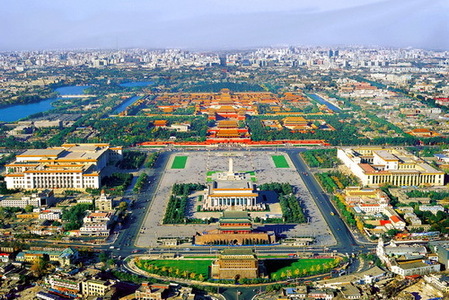World Cultural Heritage status awaits Beijing's unique 'central axis'

Beijing plans to speed up the process of protecting its old city in the next five years before it applies for World Cultural Heritage status. In particular, it will revamp its iconic "central axis",
Di'anmen, the only historic gate missing from the central axis, is expected to be rebuilt slightly south of its original location, Kong Fanzhi, director of Beijing Municipal Bureau of Cultural Heritage, was quoted by Sunday's China Daily as saying.
"It was only a one-storey gate, unlike the other eight relics such as Qianmen or Yongdingmen which stand individually as gates. Di'anmen made up part of the city walls," Zhao Shu, a researcher at the Beijing Research Institute of Culture and History, told the English newspaper.
Originally located north of the line in Xicheng district, the relic was built in 1420 during the Ming Dynasty (1368-1644). To make way for road building, the gate was demolished in 1955 when the campaign to demolish the old city's encircling walls was at its greatest.
Two structures related to Yongdingmen, which were at the southern end of the axis, will also be rebuilt.
Yongdingmen, the former front gate safeguarding the old city, was torn down in 1957 to make way for the new road system.
However, the gate tower was rebuilt in 2005 despite debate among experts about whether the rebuilding was meaningful; the new structure was likely to be different from the original building. The watchtower and its wengcheng, which translates into "urn city", was set between the gate tower and watchtower and is still missing.
Both rebuilding plans do not yet have a clear timetable, said Kong.
The central axis, which runs north to south directly through the heart of the capital, extends 7.8 km from what was Di'anmen to Yongdingmen. Other gates on the line include Zhengyangmen, Tian'anmen, Duanmen, Wumen, Taihemen, Qianqingmen and Shenwumen.
Often referred to as a "dragon vein", several important royal buildings were built along the axis including the world-famous Forbidden City and Jingshan (Coal Hill) Park, an imperial garden built during the Ming dynasty.
According to Zhao, whose opinion is shared by many scholars, the central axis made the city's layout unique.
"It was a very smart idea to make the city's important architecture and general layout along the lines east and west symmetrical. Therefore, protecting the axis will preserve the uniqueness of the city," Zhao said.
According to some media reports, revamping the "dragon vein" by rebuilding the missing gate will also bring good fengshui.
The capital is continuing its investment in the protection of its heritage with about 150 million yuan (29 million U.S. dollars) expected to be spent annually for the next five years.
The city is collecting suggestions from the public about the agenda for protecting the old city from 2011 to 2015. At the same time, the preparation for applying for World Cultural Heritage status is speeding up and a coordination and consultation team will be set up soon. The application will be made within the next five years.
However, experts have different opinions on whether the rebuilding will have a positive impact on the application for world heritage status and even on the protection of the old city.
"The most important thing a potential world heritage site needs to have is that it is faithful to history. It is just a replica after you rebuild it, as it is no longer what it was," said Gu Jun, a scholar studying ancient architecture at the Chinese Academy of Cultural Heritage.
Rebuilding is not particularly valuable, according to He Shuzhong, founder of Beijing Cultural Heritage Protection Center, an NGO involved in preserving the city's past.
"Preventing new damage is more important," He said.
 0
0 







Go to Forum >>0 Comments